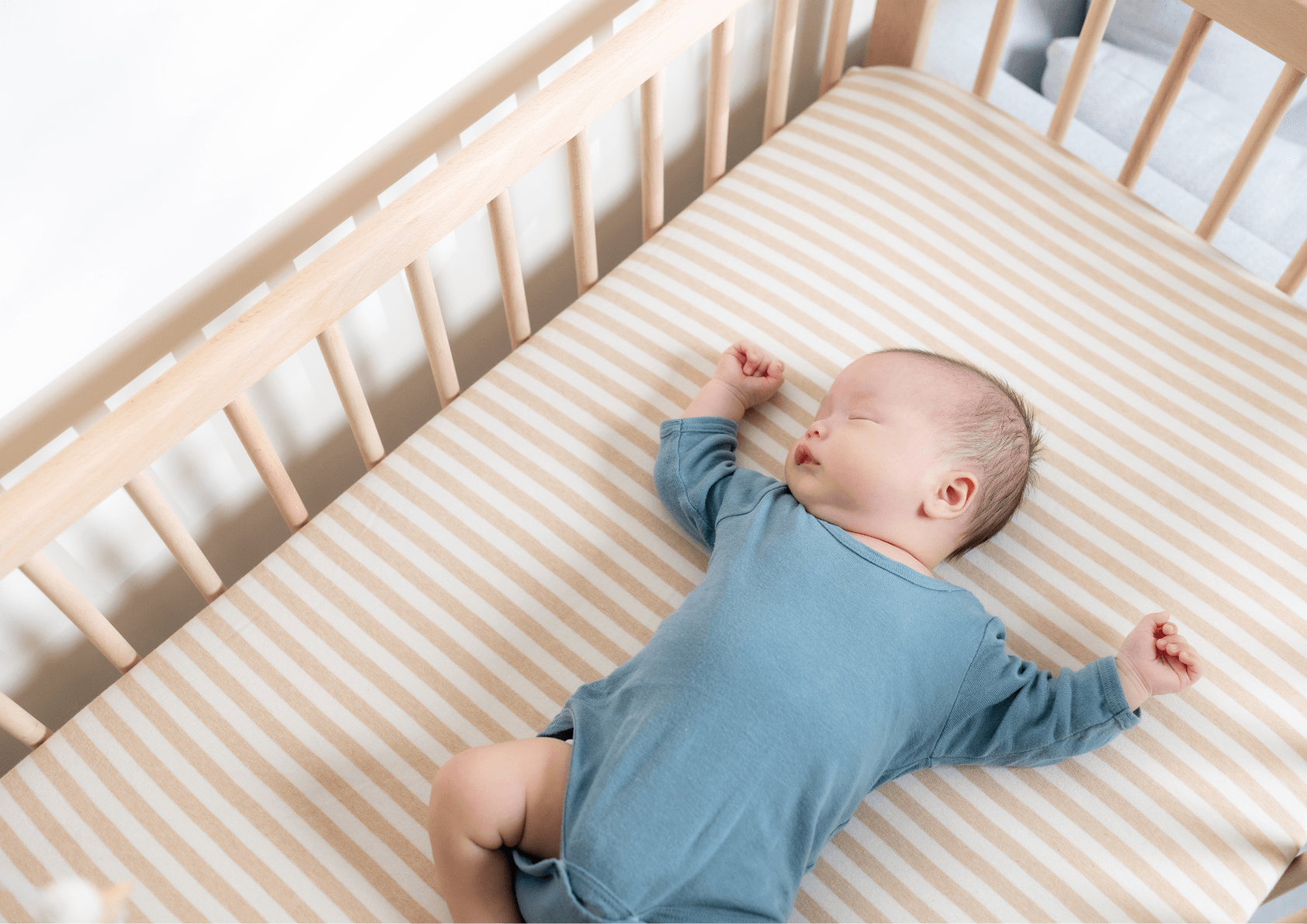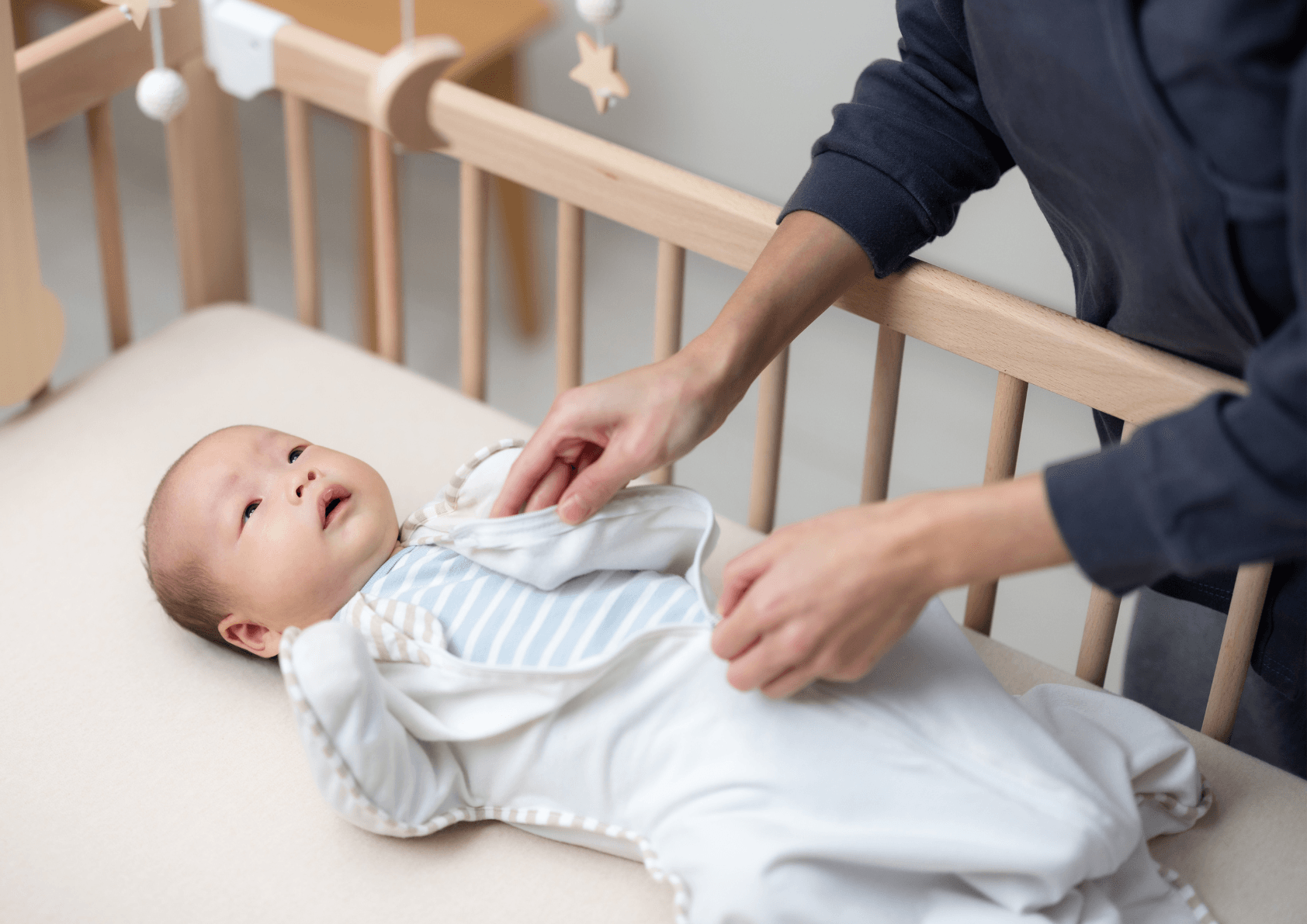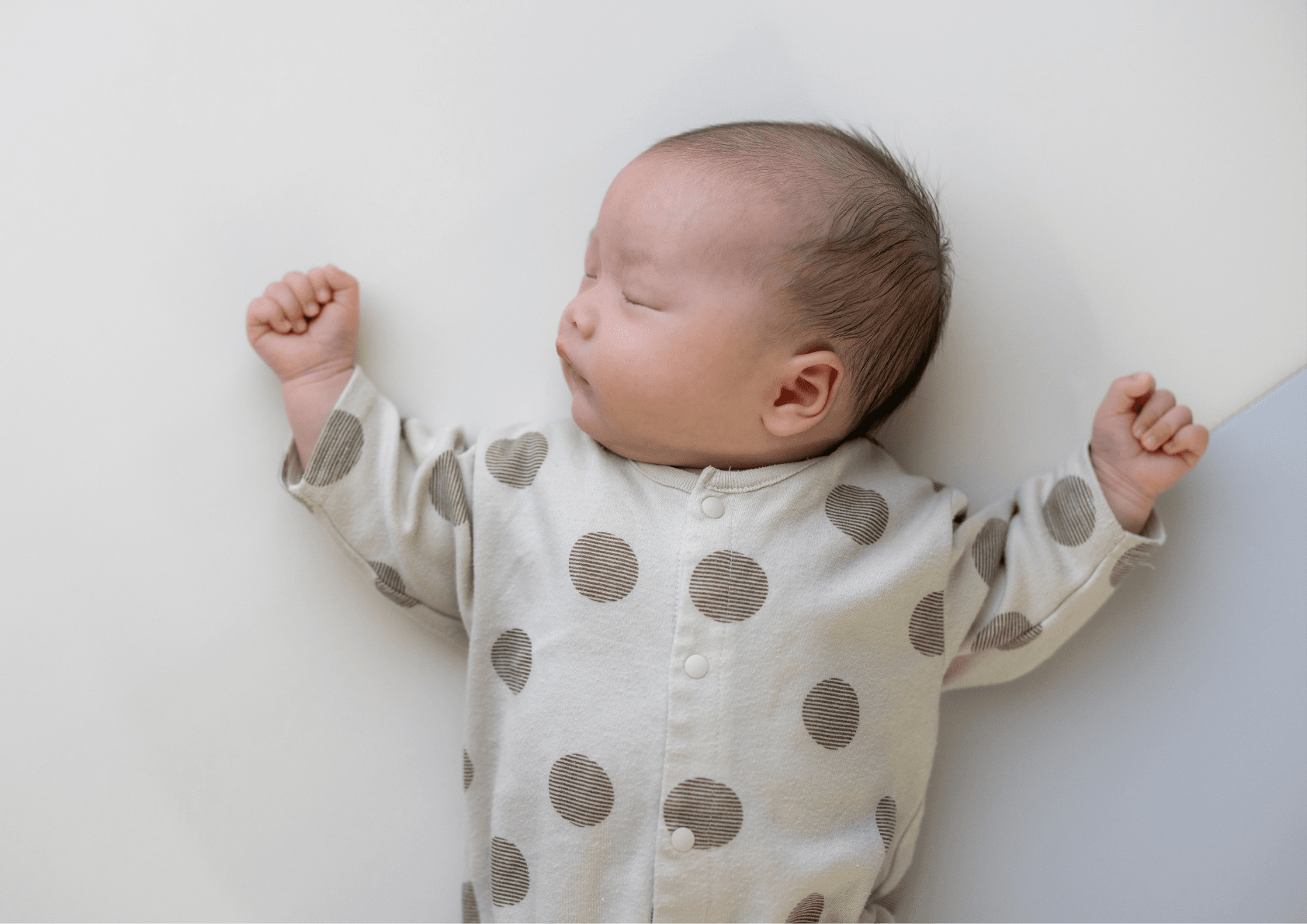What to Dress a Newborn in at Night

In the first few weeks, figuring out how to dress your baby at night is less about Pinterest-perfect nursery shots and more about knowing what keeps your baby safe, comfortable, and asleep for more than twenty minutes at a time. Have you been left wondering 'How many layers?' 'What’s too hot?', 'Is that whimper from cold feet or a stuffy chest?'
In this article you'll get clear science backed advice on how to safely dress your newborn at night.

The basics of sleep safety
When dressing your baby for sleep, your number one goal is a safe sleeping environment. That means dressing them in a way that helps regulate body temperature and reduces the risk of sudden infant death syndrome (SIDS), also called cot death.
That starts with a firm, flat mattress and a well secured sheet in your baby’s cot. No pillows. No loose blankets. No stuffed animals—however adorable they can all be a suffocation or choking risk.
Babies need a calm, clear space and to be dressed comfortably in clothes that match the temperature of the room.
How do I know if my baby is the right temperature?

Babies can’t say, “I’m roasting under here!” but their bodies will often tell you. Gently hold your hand to your baby’s chest, or feel your baby’s neck or tummy. If it’s warm but not clammy, you’re in the right zone.
Cold fingers and toes are normal, so don't panic if your baby’s fingers or baby’s feet feel cooler than the rest of them. It’s your baby’s chest or back that gives you the best clue about the overall temperature.
What is the safe temperature for a babies bedroom?
Your baby’s room should sit comfortably between 16 and 20°C. That’s the sweet spot for most babies and helps avoid both overheating and getting too cold.
In hot weather, use a fan or open a window (just not directly by the cot). In cold weather, make sure the space is warm—but not so warm that baby’s head starts to sweat. Whether it’s warmer nights or chilly ones, adjusting the layers your baby wears is key.
How many layers should my baby wear?

When in doubt, think of it like this - dress your baby in one more layer than you’re wearing. That could be a sleepsuit over a vest, with a sleeping bag over the top if needed. A baby sleepwear guide can help if you're unsure.
In cold weather, an extra layer like a footed onesie, plus a tog-rated sleeping bag, keeps your baby warm and helps your baby’s body stay at a steady temperature.
In warmer weather or on hot nights, you can strip it back. Maybe just a lightweight cotton bodysuit and a light sleeping bag. The goal is to keep your baby snug, but not sweaty.
What are sleeping bags?
Sleeping bags (also called sleep sacks) are a game changer. They stop your baby from kicking off blankets, getting cold, or ending up with fabric over your baby’s face. Choose one with armholes and a fitted neck to keep your baby safe and supported.
Make sure the tog rating matches the room’s temperature. And always leave your baby’s head uncovered. Hats and hoods might look cute but pose a real risk—overheating, or worse, covering baby’s face entirely.
Are Cellular Blankets Safe?

Lightweight cellular blankets are still a great option—especially for small babies or young babies not yet rolling over. Just be sure to use only one, tuck it firmly under the mattress, and keep it at chest height. That way it won’t slip up over your baby’s shoulders or face.
Avoid extra blankets or layers unless the room is genuinely cold and your baby shows signs of feeling chilly. Even then, a sleeping bag or one extra layer of clothing is usually safer.
What's the best material for my babies clothes?
Newborn babies have sensitive skin, so baby clothes should be breathable, soft, and simple. Cotton is perfect. Steer clear of bulky outfits, itchy seams, or anything with a scratchy label.
Always check your baby’s body—not just your baby’s hands or baby’s feet—to gauge comfort. Clothes should cover your baby’s chest, baby’s shoulders and baby’s legs without being too tight. And if your baby is in a car seat, remember that extra layers can cause overheating. A warm car can quickly become too warm.
Remove hats or mittens when you go indoors, even in winter. They’re helpful outside, but in a warm car or house, they can cause baby’s temperature to rise fast.
How many layers is too many?
For newborns, aim for one more than you’re wearing. Use layers so you can add or remove based on how baby feels. In warmer nights, reduce to one or two. In cold weather, an extra layer might be needed. The key is to check often—your baby’s temperature can change faster than you’d expect.
If your baby’s face is flushed or sweaty, remove a layer. If their tummy feels cool and they’re fussing, add one. Baby sleepwear is about flexibility, not a fixed rulebook.
How to dress your baby when they have a fever
When your baby has a fever, the primary goal when dressing them for sleep is to help their body release heat and cool down comfortably. Avoid the urge to bundle them up, even if their hands or feet feel cool. Overdressing can trap heat and potentially elevate your babies temperature further. Instead, opt for just one layer of lightweight and breathable clothing, such as a single cotton bodysuit or even just a nappy, depending on the temperature of their room.
It's also important to ensure that the baby's room is kept at a comfortably cool temperature, ideally within the recommended range of 16 to 20°C. You might consider gently increasing air circulation with a fan, ensuring it's not directed straight at your baby. Regularly monitor your baby's temperature to assess if it's decreasing. How you dress them is a supportive measure, but always follow your healthcare provider's advice on managing the fever, including any prescribed medication and ensuring adequate fluid intake.
Avoid using extra blankets when your baby has a fever, as these can also hinder heat loss. If your baby experiences chills, a very thin additional layer can be used temporarily until the chills subside. The focus should be on keeping your baby as comfortable as possible while their body recovers. Always prioritize light and breathable clothing and avoid anything that seems to be making them feel hotter or more distressed. Remember that appropriate dressing is part of fever care, but seeking professional medical advice is crucial for proper management.
How to dress older babies for safe sleep
For older babies (6-12 months), continue using a sleeping bag with the appropriate TOG rating for the room temperature (aim for 16-20°C). Alternatively, opt for well-fitting footed pajamas or a two-piece pajama set made of breathable cotton. Ensure pajamas aren't too loose or have any dangling ties or buttons that could be a hazard.
In a 16-20°C room, a long-sleeved cotton pajama set or footed pajamas are often sufficient. You might add a thin vest underneath in cooler conditions or use a lighter weight sleeping bag in warmer conditions. Avoid dressing them in more than one or two light layers. Always feel their chest or the back of their neck to check if they feel comfortably warm, not sweaty or cool. If their hands or feet feel cool, that's usually normal. The key is to avoid overheating while ensuring they aren't cold enough to wake.
Common mistakes to avoid with your baby's clothing
Here are some common mistakes to avoid when you dress baby
Overdressing with Bulky Clothes: Avoid dressing your baby in bulky or thick clothing. Overheating is a significant risk factor for sudden infant death syndrome (SIDS). Instead, opt for lightweight layers that allow for breathability and temperature regulation. Remember the general guideline: dress your baby in one more layer than you would wear to feel comfortable in the same room temperature. Check your baby's chest or back to ensure they feel warm, not hot or sweaty.
Using Loose Blankets in the Cot: Loose blankets pose a serious choking and suffocation risk for babies under 12 months. They can easily cover the baby's face, obstructing their airway. Instead of blankets, use a safe baby sleeping bag or wearable blanket with a fitted neck and armholes that corresponds to the room temperature (TOG rating). If you choose to use a lightweight cellular blanket (for young babies not yet rolling), it should be thin, made of breathable material like cotton or muslin, and firmly tucked in no higher than your baby's chest, lying flat below their arms to prevent them from wriggling down and becoming entangled. Never double over blankets.
Leaving Hats On Indoors or While Sleeping: While hats are essential for keeping your baby warm outdoors in cold weather, they should never be worn indoors or while sleeping. Babies primarily regulate their body temperature through their head. Covering their head can lead to overheating, which is a SIDS risk factor. A bare head is safest for sleep.
Choosing Outfits with Unsafe Fastenings: Be cautious of baby clothes with zips, snaps, or seams near the baby's neck, especially if they are tight or can dig into the baby's sensitive skin. Always check that nothing is causing pressure or irritation. Similarly, avoid clothing with loose ribbons, ties, or large buttons that could detach and become a choking hazard. Ensure any fastenings are well-secured.
Missing Irritating Labels and Tags: Always check baby clothes for labels and tags that could rub or irritate your baby's delicate skin. Remove any that feel rough or are poorly positioned. Look for clothing with flat seams and soft materials.
Skipping Breathable, Natural Fabrics: Synthetic fabrics may not breathe as well as natural fibers like cotton, potentially leading to overheating or skin irritation. Opt for soft, breathable materials such as cotton or merino wool for baby's sleepwear. These materials help regulate body temperature and are gentler on baby's skin. Ensure that the chosen baby clothes have a low fire danger label for added safety.
Dressing baby for different temperatures
In summer or during a heatwave, dress baby in just a vest or nappy with a low tog sleeping bag or a lightweight blanket. Keep the room cool, avoid direct sun, and always check that your baby feels warm, not hot.
In winter, layer up. A sleep suit, a vest underneath, and a sleeping bag on top can keep your baby snug without the need for extra blankets. Make sure baby’s cot isn’t next to a radiator or under a window, and always remove outdoor layers when you come inside.
Final Thoughts: Sleep Safe, Sleep Well
There’s no magic formula for dressing your baby. But there are solid guidelines—and a bit of instinct. If you keep your baby’s cot safe, dress your baby in breathable layers, and regularly check your baby’s temperature, you’re doing brilliantly.
You’ll learn to read your baby’s body language, from the scrunch of your baby’s fingers to the wriggle of their little legs. Some babies like feeling snug. Others run hot. Most babies let you know one way or another.
So trust yourself. Use a baby sleepwear guide when in doubt. And remember, both you and your baby deserve a good night’s sleep—even if it comes in two-hour bursts for now.

